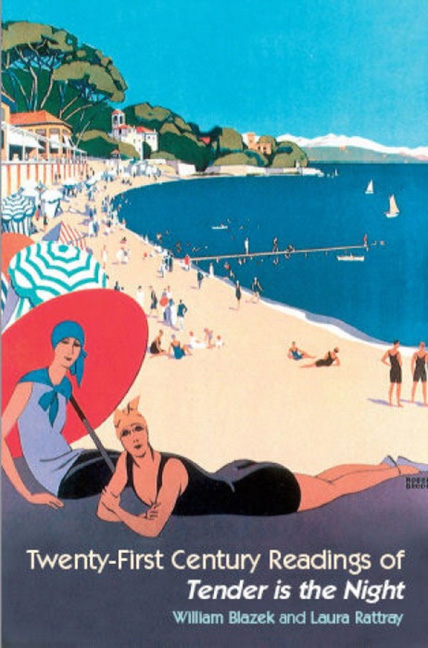Book contents
- Frontmatter
- Contents
- Acknowledgements
- List of Illustrations
- Introduction
- 1 ‘Can't We Put it in Writing?’: Some Short Precursors to Tender Is the Night
- 2 Tender Is the Night, ‘Jazzmania’, and the Ellingson Matricide
- 3 Sanatorium Society: The ‘Good’ Place in Tender Is the Night
- 4 ‘Some Fault in the Plan’: Fitzgerald's Critique of Psychiatry in Tender Is the Night
- 5 An ‘Unblinding of Eyes’: The Narrative Vision of Tender Is the Night
- 6 Si le soleil ne revenait pas: Swiss Clockwork Gone Mad in Tender Is the Night
- 7 ‘A Unity Less Conventional But Not Less Serviceable’: A Narratological History of Tender Is the Night
- 8 American Riviera: Style and Expatriation in Tender Is the Night
- 9 ‘Out Upon the Mongolian Plain’: Fitzgerald's Racial and Ethnic Cross-Identifying in Tender Is the Night
- 10 Gender Anxiety: The Unresolved Dialectic of Fitzgerald's Writing
- 11 Tender Is the Night and the Calculus of Modern War
- 12 Reading Fitzgerald Reading Keats
- Notes on Contributors
- Index
5 - An ‘Unblinding of Eyes’: The Narrative Vision of Tender Is the Night
- Frontmatter
- Contents
- Acknowledgements
- List of Illustrations
- Introduction
- 1 ‘Can't We Put it in Writing?’: Some Short Precursors to Tender Is the Night
- 2 Tender Is the Night, ‘Jazzmania’, and the Ellingson Matricide
- 3 Sanatorium Society: The ‘Good’ Place in Tender Is the Night
- 4 ‘Some Fault in the Plan’: Fitzgerald's Critique of Psychiatry in Tender Is the Night
- 5 An ‘Unblinding of Eyes’: The Narrative Vision of Tender Is the Night
- 6 Si le soleil ne revenait pas: Swiss Clockwork Gone Mad in Tender Is the Night
- 7 ‘A Unity Less Conventional But Not Less Serviceable’: A Narratological History of Tender Is the Night
- 8 American Riviera: Style and Expatriation in Tender Is the Night
- 9 ‘Out Upon the Mongolian Plain’: Fitzgerald's Racial and Ethnic Cross-Identifying in Tender Is the Night
- 10 Gender Anxiety: The Unresolved Dialectic of Fitzgerald's Writing
- 11 Tender Is the Night and the Calculus of Modern War
- 12 Reading Fitzgerald Reading Keats
- Notes on Contributors
- Index
Summary
Tender is the Night is a definitely post-war, pre-depression story, and as such it has (in addition to its other virtues) a certain archaeological value. (Fadiman 112)
Whatever its merits, Tender Is the Night is considered to be a novel that has never quite made the grade as a genuine 1930s’ text. Whether dismissed as a tedious, fag-end Jazz Age tale or hailed as a beautifully written retrospective, the implication lingers that the novel is not truly contemporary, but essentially a belated, honorary 1920s’ piece. The small matter of the novel's publication date – when not ignored – is a fact commonly regarded as accidental, particularly amidst the dazzle of biographical approaches to Fitzgerald's oeuvre. Accounts of a narrative begun in earnest in the mid-twenties but only finished nine years later are cited to add credence to the notion that Tender in its existing form would have been a published twenties’ text had its completion not been thwarted by bouts of family illness, dissipation, alcoholism and financial strife. While this is a myth (the seventeen manuscript drafts resulted in a very different novel from that conceived in 1925), it has threatened to become overpowering, helping to fuel an assumption that, whatever its virtues, this 1934 work can be slotted into American literary chronology as a novel that essentially draws Fitzgerald's account of the twenties to a close.
With Tender, however, Fitzgerald succeeded in producing the unexpected – and the fact that he did so left a long trail of critical unease. From the outset, there has been tangible discomfort over the seemingly flawed narrative form and structure; reviewers infamously described the novel as appearing ‘slung together rather than constructed’, ‘incoherent’, a ‘sprawling, undisciplined, badly co-ordinated book’, confused and rambling as ‘the author loses his grip upon the theme’. Such responses would in time serve to facilitate Malcolm Cowley's controversial 1951 revised edition, denying authorial innovation in favour of a more symmetrical, chronological, in short more ‘conventional’ version of the novel.
- Type
- Chapter
- Information
- Twenty-First Century Readings of ‘Tender is the Night’ , pp. 85 - 102Publisher: Liverpool University PressPrint publication year: 2007

